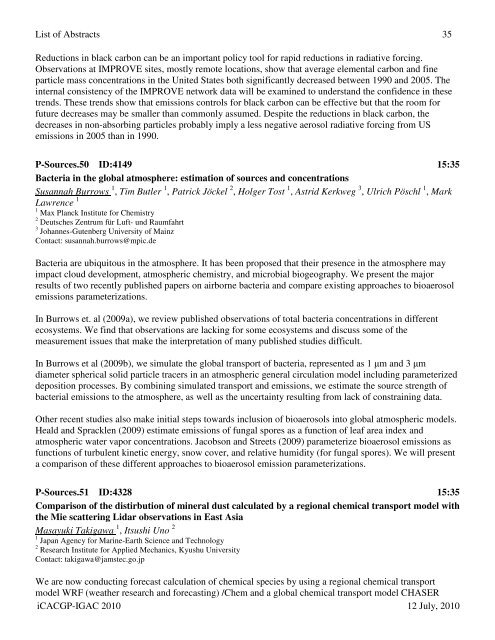Download Abstracts Here - IGAC Project
Download Abstracts Here - IGAC Project
Download Abstracts Here - IGAC Project
Create successful ePaper yourself
Turn your PDF publications into a flip-book with our unique Google optimized e-Paper software.
List of <strong>Abstracts</strong> 35Reductions in black carbon can be an important policy tool for rapid reductions in radiative forcing.Observations at IMPROVE sites, mostly remote locations, show that average elemental carbon and fineparticle mass concentrations in the United States both significantly decreased between 1990 and 2005. Theinternal consistency of the IMPROVE network data will be examined to understand the confidence in thesetrends. These trends show that emissions controls for black carbon can be effective but that the room forfuture decreases may be smaller than commonly assumed. Despite the reductions in black carbon, thedecreases in non-absorbing particles probably imply a less negative aerosol radiative forcing from USemissions in 2005 than in 1990.P-Sources.50 ID:4149 15:35Bacteria in the global atmosphere: estimation of sources and concentrationsSusannah Burrows 1 , Tim Butler 1 , Patrick Jöckel 2 , Holger Tost 1 , Astrid Kerkweg 3 , Ulrich Pöschl 1 , MarkLawrence 11 Max Planck Institute for Chemistry2 Deutsches Zentrum für Luft- und Raumfahrt3 Johannes-Gutenberg University of MainzContact: susannah.burrows@mpic.deBacteria are ubiquitous in the atmosphere. It has been proposed that their presence in the atmosphere mayimpact cloud development, atmospheric chemistry, and microbial biogeography. We present the majorresults of two recently published papers on airborne bacteria and compare existing approaches to bioaerosolemissions parameterizations.In Burrows et. al (2009a), we review published observations of total bacteria concentrations in differentecosystems. We find that observations are lacking for some ecosystems and discuss some of themeasurement issues that make the interpretation of many published studies difficult.In Burrows et al (2009b), we simulate the global transport of bacteria, represented as 1 µm and 3 µmdiameter spherical solid particle tracers in an atmospheric general circulation model including parameterizeddeposition processes. By combining simulated transport and emissions, we estimate the source strength ofbacterial emissions to the atmosphere, as well as the uncertainty resulting from lack of constraining data.Other recent studies also make initial steps towards inclusion of bioaerosols into global atmospheric models.Heald and Spracklen (2009) estimate emissions of fungal spores as a function of leaf area index andatmospheric water vapor concentrations. Jacobson and Streets (2009) parameterize bioaerosol emissions asfunctions of turbulent kinetic energy, snow cover, and relative humidity (for fungal spores). We will presenta comparison of these different approaches to bioaerosol emission parameterizations.P-Sources.51 ID:4328 15:35Comparison of the distirbution of mineral dust calculated by a regional chemical transport model withthe Mie scattering Lidar observations in East AsiaMasayuki Takigawa 1 , Itsushi Uno 21 Japan Agency for Marine-Earth Science and Technology2 Research Institute for Applied Mechanics, Kyushu UniversityContact: takigawa@jamstec.go.jpWe are now conducting forecast calculation of chemical species by using a regional chemical transportmodel WRF (weather research and forecasting) /Chem and a global chemical transport model CHASERiCACGP-<strong>IGAC</strong> 2010 12 July, 2010








